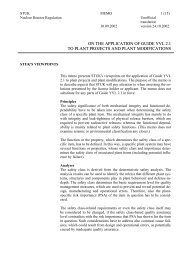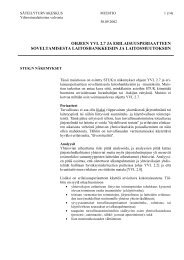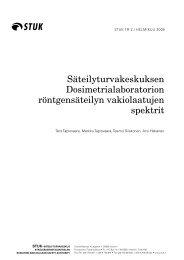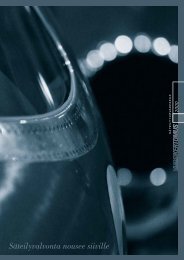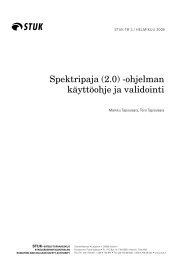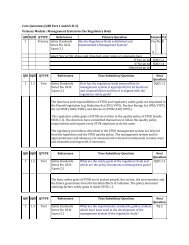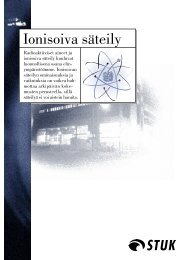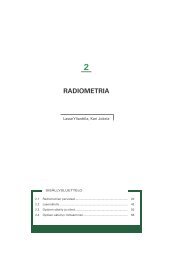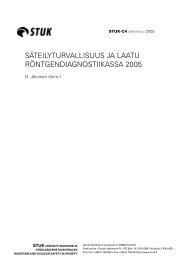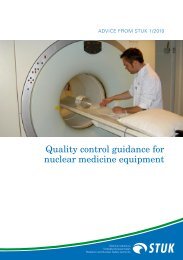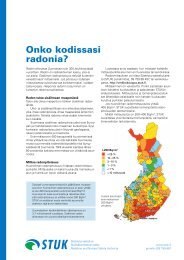Whole report - STUK
Whole report - STUK
Whole report - STUK
You also want an ePaper? Increase the reach of your titles
YUMPU automatically turns print PDFs into web optimized ePapers that Google loves.
<strong>STUK</strong>-YTO-TR 175<br />
2000<br />
1800<br />
244<br />
Cm neutron counts (cps)<br />
1600<br />
1400<br />
1200<br />
1000<br />
800<br />
600<br />
400<br />
#13857<br />
#16732<br />
200<br />
0<br />
200 300 400 500 600 700 800 900<br />
Gross gamma (arbitrary units)<br />
Figure 24. 244 Cm neutrons vs. the gross gamma signal. Dotted lines describe the error corridor.<br />
Table IX. Neutrons vs. burnup, parameters of equation (15). UL and LL indicate the parameters of the<br />
upper and lower limit, respectively, of the error corridor, shown by dotted lines in Figure 19.<br />
PYVO<br />
Experimental<br />
UL<br />
LL<br />
Experimental<br />
Enrichment<br />
correction<br />
a s<br />
a<br />
b<br />
a<br />
s b<br />
R 2<br />
yes<br />
– 4.27<br />
0.03<br />
4.65<br />
0.02<br />
1.000<br />
yes<br />
– 3.95<br />
0.13<br />
4.44<br />
0.09<br />
0.990<br />
yes<br />
– 3.82<br />
4.43<br />
yes<br />
– 4.08<br />
4.46<br />
no<br />
– 2.10<br />
0.22<br />
3.22<br />
0.15<br />
0.946<br />
6.2.2 Correlation of neutron signal to<br />
burnup<br />
Neutrons were correlated to burnup according to<br />
equation (15):<br />
log N = a + b* log B ,<br />
(15)<br />
10 ( ) 10 ( )<br />
where N is the measured neutron count rate. a<br />
and b are the parameters received from the fit.<br />
The results are shown in Table IX. The fit of the<br />
experimental results coincide within the statistical<br />
accuracy to the corresponding fit of the PYVO<br />
calculations.<br />
The fit is much worse, if the enrichment correction<br />
is not applied. Furthermore, the fitting parameters<br />
deviate significantly from the results<br />
calculated with PYVO. The results calculated using<br />
data without the enrichment correction are<br />
also shown in Table IX.<br />
The value of b in equations (11) and (15) has<br />
been calculated by Anttila and Tanskanen. According<br />
to Anttila’s ORIGEN-2 calculations, b varies<br />
from 4.5 to 4.8 [16]. Tanskanen has determined<br />
the value of b by a series of ORIGEN-S calculations,<br />
which imply that b = 4.67 (when moderator<br />
density = 0.5 g/cm 3 and initial enrichment = 3.0%)<br />
and b = 5.03 (when moderator density = 0.752 g/<br />
cm 3 and initial enrichment = 3.0%) [11]. The<br />
values of b obtained from the measurement results<br />
(Table IX) correspond quite well to these<br />
calculated values.<br />
The error corridor for the measured 244 Cm<br />
neutron counts vs. burnup curve is shown in<br />
Figure 19. The parameters of the upper and lower<br />
limiting curves of the error corridor are also given<br />
in Table IX. The width of this error corridor is<br />
about ±4.6%.<br />
6.2.3 Correlation of neutron signal to<br />
gamma signal<br />
Neutrons were correlated to the measured 137 Cs<br />
peak intensity and the gross gamma signal according<br />
to the equations:<br />
log N a ¢ b¢ log A ,<br />
(16)<br />
10 ( ) = + *<br />
10 ( 37 )<br />
log N a b log G ,<br />
10 ( ) = ¢¢ + ¢¢ *<br />
10 ( 37 )<br />
(17)<br />
where a¢, b¢, a² and b² are parameters received<br />
from the fit. Enrichment correction has been applied<br />
to the neutron data of these fits. The results<br />
are shown in Tables X and XI and plotted in Figu-<br />
24



